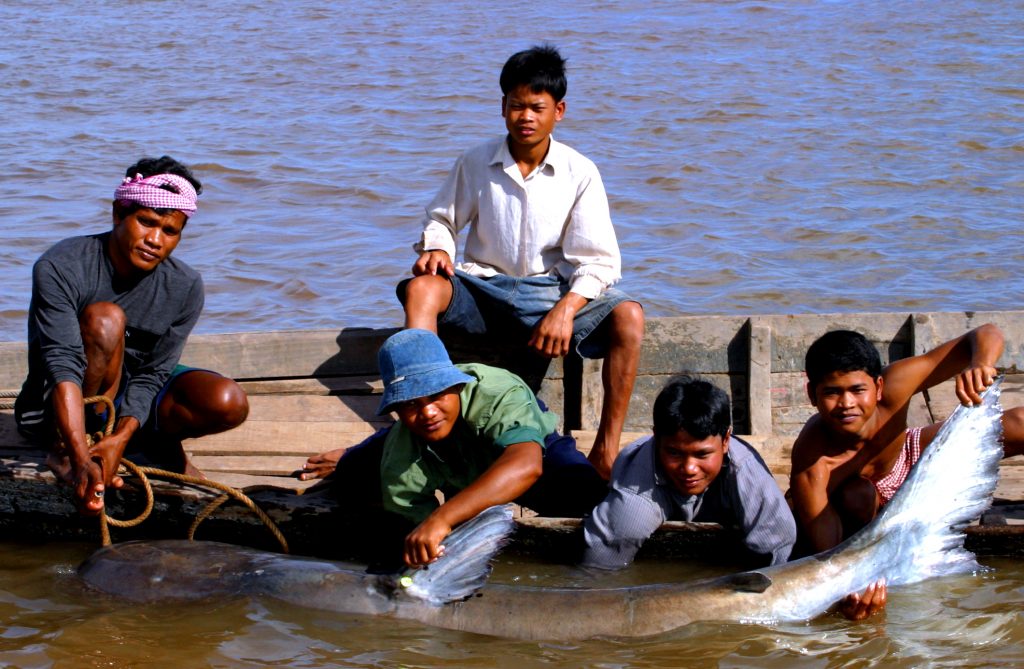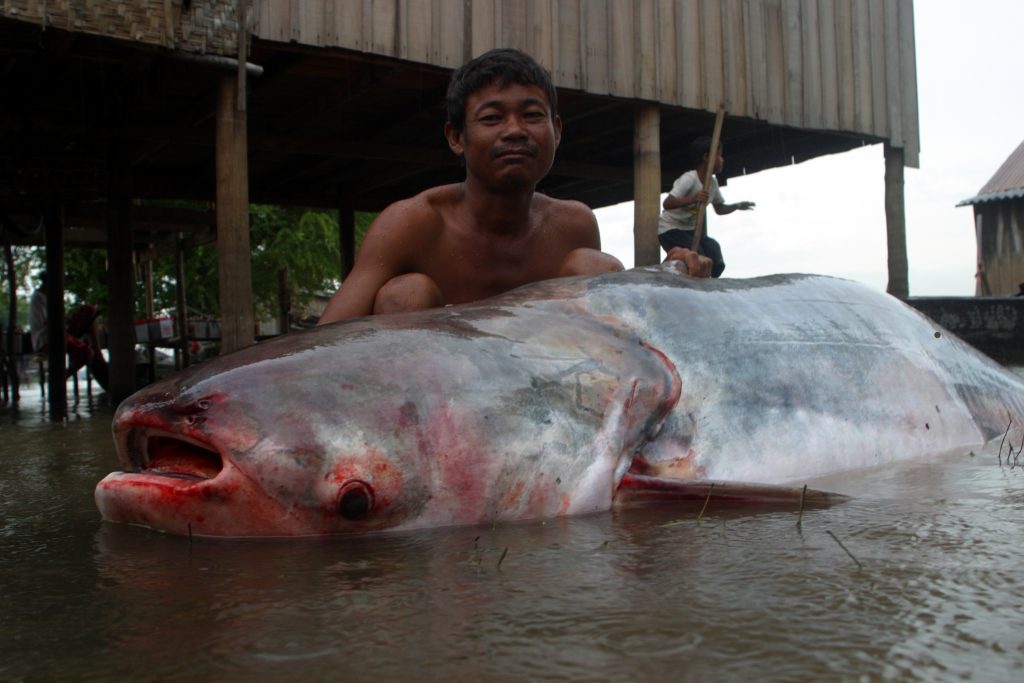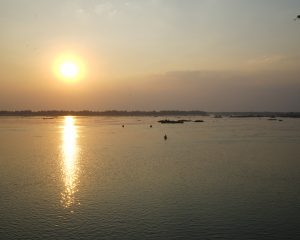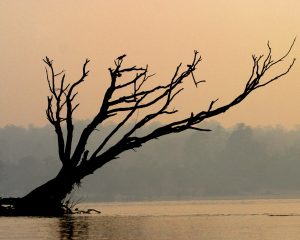Billions of fish make an annual trek through the rivers of Southeast Asia, supporting millions of people. Yet scientists still don’t know much about them. Read about the Wonders of the Mekong project.
This is the second story in the Wonders of the Mekong series that I began writing in 2017. You can read the story, which was published on March 29, 2017, here on National Geographic.
Tonle Sap River, Cambodia — Some of the world’s greatest animal migrations take place on land, like the wildebeests traversing the East African plains and caribou crossing the Alaskan tundra. Other epic journeys are made in the air: monarch butterflies seeking mountain shelter in Mexico or songbirds traveling thousands of miles to reach their tropical wintering grounds.
But one of the most important treks—and definitely one of the largest, in terms of sheer numbers of animals on the move—occurs out of view, in the murky depths of the Tonle Sap River in Cambodia, where each year billions of fish of all shapes and sizes embark on one of the most incredible animal migrations on the planet.
“This is a huge, spectacular event that most people have never heard of,” says Zeb Hogan, a National Geographic fellow and host of the TV show Monster Fish on Nat Geo Wild.
Hogan is in Cambodia researching and documenting the migration as the leader of a USAID project called “Wonders of the Mekong,” which focuses on the sustainable development of the rivers and landscapes of the Lower Mekong River Basin.
First Go the Giants
The migration starts in late September or early October, just after the floodwaters of the Tonle Sap Lake (Southeast Asia’s largest) reach their peak and the huge lake expels vast quantities of water and fish down the Tonle Sap River, which connects the lake to the Mekong River.
The first fish to begin the journey are among the world’s largest, such as the Mekong giant catfish, which can grow 10 feet long and 600 pounds. The species is called ‘trey reach’ or royal fish in Cambodia, signifying the special status of the giant catfish in the Khmer heritage. With the catfish comes the almost equally super-sized giant barb, a carp species that, like the giant catfish, is critically endangered. The giant barb, symbolizing the importance and significance of fish here, is the national fish of Cambodia.

Mekong giant catfish 
Another Mekong giant catfish
Over the following months, they are followed by up to 100 different kinds of fish, including striped tiger perch, freshwater pufferfish, and slimy mud eels. For reasons unknown to researchers, the numbers peak each month a few days before the full moon.
By January, the small, silvery carp known as “trey riel,” or “money fish,” make up the bulk of the aquatic travelers. At that time, Hogan says, the river is so choked with fish that “you’ll see people with little scoop nets put them into the water and come up filled with fish.”
The migration is closely connected to the seasonal flows of the river system. For most of the year, the Tonle Sap runs south for about 75 miles (120 kilometers) from the lake down to Phnom Penh, the Cambodian capital, where it joins the larger Mekong River. During the summer monsoon rains, however, the Mekong River dramatically rises, with its floodwaters pushing up the Tonle Sap.
This causes the Tonle Sap to reverse its course, making it one of only a handful of rivers worldwide to do so. Young fish coming from spawning grounds further up the Mekong are brought up the Tonle Sap and into the lake, where they hide and grow fat as the lake grows up to ten times its dry-season size.
Then, in September and October, as the rains end and the flood waters ebb, the river stills, then slowly begins to flow south again. This is when the great migration begins.
Silver Bounty
Not surprisingly, thousands of fishermen, using all kinds of seines, gill nets, and scoop nets, descend on the Tonle Sap during the annual migration to take advantage of the river’s bounty.
The largest and most complicated gear used for fishing is called a “dai” or stationary bagnet. Fourteen rows of these tent-shaped nets, 63 in total, sit in the Tonle Sap River from October until March, scooping up fish as they make their way downstream. In just one hour, one such net, 80 feet wide and 330 feet long, can catch over five tons of fish.
That efficiency was vividly demonstrated during a recent visit. Every half hour, the workers stationed on what is essentially a floating houseboat pull in another bulging catch with the dai.
After a crane drops the fish onto the deck, workers pick out the larger species, including juvenile giant catfish and freshwater croaker, before shoveling the silvery trey riel into a barrel. When full, the barrels are loaded onto a skiff and taken ashore. By that time, the net is already back in the river.
Most of the trey riel is used to make a salty fermented paste called “pra hoc,” which is a staple food for the millions of people living along the Mekong. In some years, trey riel are so plentiful that whole communities gather on the river banks to clean and process them, with people stepping on them like grapes.
So just how many fish make their way down the Tonle Sap each year?
Researchers do not have the means to accurately count billions of fish as they move underwater, sometimes at depths of more than 110 feet. But they can use data from catches to make estimates. In the record 2011-2012 season, the dai fishery brought in 46,000 tons of fish. That, says Hogan, translates to about five billion individual fish.
The question then becomes: how many of the traveling fish end their journeys in the nets? Lao Sreang, the owner of one dai, believes the catch rate could be as high as 90 percent.
Looking at the myriad of nets along the Tonle Sap it’s easy to believe him. On the other hand, the dais farthest down the line at times collect just as much fish as the upper dais, suggesting that many of the fish do get through.
“The actual number of fish migrating down the Tonle Sap River in peak years is likely to be much greater than five billion,” says Hogan.
He estimates that the biomass of fish could be as great as the combined herds of wildebeest, zebra, and gazelle moving across the East African plains. Or 100 times the number of songbirds that migrate between Europe and Africa each year.
Tracking the Massive Movement
However, the number was certainly much greater in the past, as overfishing, habitat loss, and dam building have taken a heavy toll on fish populations, especially larger fish, in much of the Mekong River system. Carvings on the walls of the thousand-year-old temple complex of Angkor suggest a time when giant catfish and giant carp were much more abundant.
To learn more about the migration and how it is affected by the changes in the Mekong, Hogan and his team will continue to tag fish to track their movements. Of the fish they’ve tagged in years past in the Tonle Sap River, some have migrated to neighboring Vietnam in the south while others have been found 200 miles upstream, near the Lao border.
“This shows how interconnected the whole system is,” said Hogan.
“Migrating fish are an extremely important component of the ecosystem services that the Mekong River and its tributaries provide each year,” he added. “The fishery alone in the Mekong River basin has an estimated value of over 10 billion dollars.”
As for the Tonle Sap migration, it may actually be dwarfed by an equally important, and even less appreciated, migration at the peak of the flood season, when hundreds of billions of baby fish, including newborn Mekong giant catfish and giant carp, are carried down the waters of the Mekong to the floodplains of central and southern Cambodia and Vietnam.
Researchers plan on studying this mass movement of mini-fish later in 2017, to better understand it as threats mount against it.

